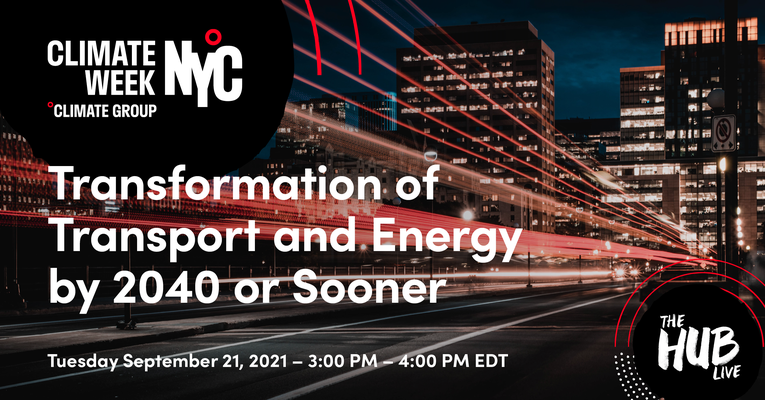Addressing climate change is a team sport. By collaborating, organizations can achieve net zero carbon emissions by 2040, if not sooner, corporate leaders told Climate Week NYC. The interrelated spheres of transportation, energy and digital infrastructure will play a central role in the process.
The transportation sector accounts for a quarter of the world’s carbon footprint. As the world recovers from the COVID-19 pandemic, opportunities are emerging for transport companies and related industries to reduce emissions and rethink infrastructure and mobility solutions. But they need to act quickly.
“We all have to be so aggressive in our actions,” said HP’s Chief Sustainability and Social Impact Officer Ellen Jackowski. Her company aims to have all of its global operations running on 100% renewable energy by 2025.
Key players are accelerating the race to net zero
“As we come back [from the pandemic], can we make room in cities for cycling, walking and outdoor activities and make an impact on individual car ownership?” asks Andrew Macdonald, senior vice president of Mobility and Business Operations at Uber. “If we don't act quickly, things will revert to normal. Private car use has already returned to pre-pandemic levels. We have to take bold action. That is why we signed the Climate Pledge last December to create more sustainable cities.”
The Climate Pledge was co-founded two years ago by Amazon and Global Optimism. It’s designed to encourage companies to accelerate plans to address the urgency of climate change by solving complex challenges through collaboration. The Pledge involves more than 200 companies across 21 countries and 25 different industry sectors that are working to build a zero-carbon economy by 2040, 10 years ahead of the Paris climate agreement.
Leading transportation companies are reducing their carbon emissions
During Climate Week NYC, urban mobility platforms Uber and Lime, leaders in the Climate Pledge's transportation sector, outlined actions they are taking to achieve net zero emissions by 2040, if not sooner.
Uber is doubling down on investment and transparency
With the Climate Pledge at front of mind, Uber has committed to:
- Making 50% of its vehicles electric by 2025 in seven European cities (London, Paris, Lisbon, Brussels, Berlin, Madrid and Amsterdam)
- Fully electrifying passenger rides in Europe, the US and Canada by 2030, and globally by 2040
- Investing $800 million to help Uber drivers transition to electric vehicles over the next five years
- Publishing a transparency report on the carbon emissions impact from the trips its drivers make using real-world data from every single ride
- Expanding Uber Green, its hybrid and electric vehicle ride request option, globally, so it’s easier for customers to make green choices
- Encouraging greater corporate transparency around carbon emissions by publishing a climate assessment and performance report
Lime knows it’s vital to engage suppliers
Lime started out as a bike-sharing company and now operates electric vehicles in more than 200 markets globally. For this forward-thinking organization, sustainability means ensuring all of its vehicles and warehouses use 100% renewable energy. “Since 2018, we've developed a lifecycle analysis on each product, its embedded carbon and how we can improve on that,” said Andrew Savage, vice president of sustainability at Lime. And for every vehicle that enters its warehouses, Lime is looking at how it can swap out parts, such as batteries, and reuse them.
“We need to engage our supply chain, way back to manufacturing, to reduce the carbon footprint of our business and products,” said Savage. “I see a future where we're all decarbonizing the nature of the products we're using. That means we all need to be lowering and lowering our carbon over time and quickly.”
Matthias Rebellius, member of the Managing Board and CEO of Smart Infrastructure at Siemens, says one of the most pressing issues is solving challenges in the supply chain. “We have only 1.3 million tonnes of CO2 in our operations and 12 million in the supply chain. The real challenge is getting into heavy industries, which are more difficult to transform.”
Greening the supply chain will depend on greening business demand
Many corporates are playing a leading role in accelerating the transformation to 100% green energy by 2025. But in some parts of the world, meeting that demand is challenging, says Jackowski of HP. “Demand outpaces supply in countries like Singapore,” she explained. “The goal is to accelerate business demand for renewable power to give companies the confidence to supply it and to request our suppliers also shift to renewables.”
Jakob Askou Bøss, senior vice-president of Corporate Strategy and Stakeholder Relations at Ørsted, one of the largest renewable energy providers in the world, says the demand side needs to align with the ambitious green energy targets set by corporates.
Governments and organizations alike must find ways to change mindsets and behaviors
Although most countries committed to reducing global warming to below 2 degrees under the Paris agreement, Bøss says national commitments are not where they should be to stay on that curve. “Aligning and accelerating national plans is key. Targets need to be translated into specific projects, so all of this gets deployed.”
In the digital infrastructure space, Dr. Nicola Peill-Moelter, director of Sustainability and Innovation at VMware, says driving companies toward more sustainable energy sources is a journey. “The way industry has operated for so long is making sure business has resiliency, but they're not always thinking about the energy efficiency of that infrastructure,” she explained. “Bringing basic awareness is a bit of challenge. We can move quickly, but we're trying to shift mindsets and behaviors and we have to accelerate how we do that.”
